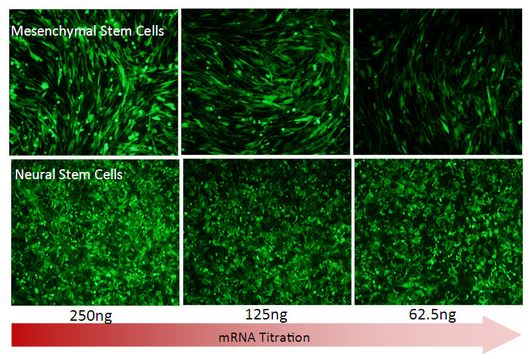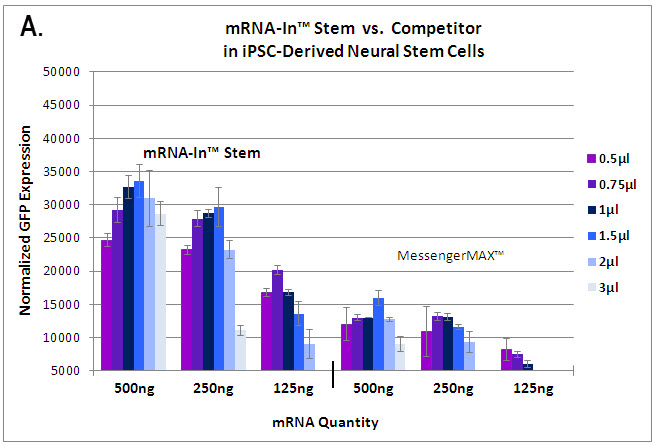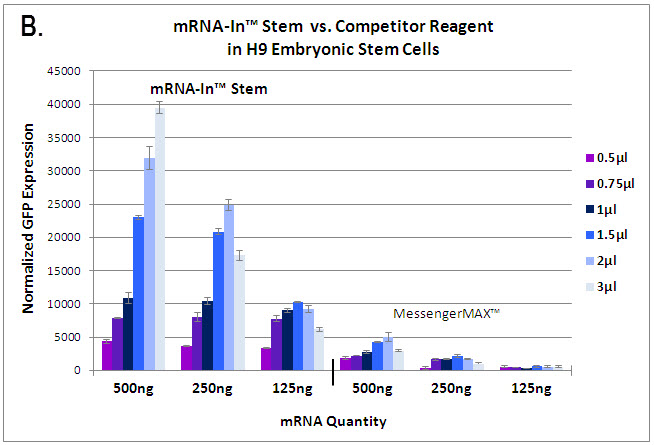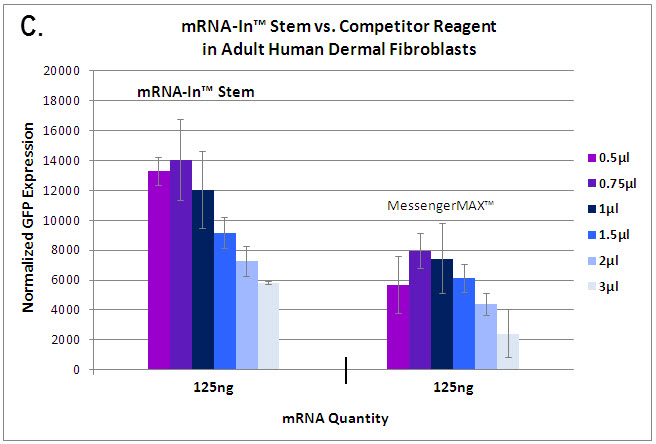Messenger RNA (mRNA) delivery has become a widely used non-viral gene delivery alternative due to its many advantages, including no risk of integration into the host genome which can leads to insertional mutagenesis and activation of oncogenes, and as shown here the ability to achieve very high transfection efficiencies, nearing that of viral delivery methods. In contrast with DNA transfection, mRNA delivery does not enter the nucleus, rather only cytosolic delivery is required, resulting in more rapid expression. mRNA-In? Stem, is specifically designed and optimized for high efficiency mRNA delivery with exceptionally low cytotoxicity in hard-to-transfect stem cells. Unlike other reagents mRNA-In? Stem requires very low amounts of mRNA to achieve maximum transfection efficiency while maintaining optimal cell viability.
mRNA-In? Stem, is a new mRNA transfection reagent specifically designed and optimized for high efficiency mRNA delivery with exceptionally low cytotoxicity in stem cells and hard-to-transfect primary cells. mRNA-In? Stem requires very low amounts of RNA to achieve maximum delivery while maintaining optimal cell viability.
Maximum efficiency with low amounts of mRNA - Maximally effective with very low amounts of mRNA, significantly minimizing potential adverse off-target cytotoxic effects and supporting maximum cell health and viability.
High expression, low toxicity - Achieves high mRNA efficiency and protein expression in embryonic and induced pluripotent stem cells while maintaining optimal cell health for uncompromised post-transfection assay results.
Robust, versatile performance - Consistently produces efficient transfection across a broad range of stem cells.

Figure 1. mRNA-In? Stem achieves maximum transfection efficiency and expression with low amounts of mRNA. Human ES and iPSC-derived stem cells were plated in 24-well plates to give 60-80% confluency on the day of transfection. Low amounts (250ng to 62.5ngs) of GFP-mRNA containing 5-methlycytosine and psuedouridine were complexed with 2-3μl mRNA-In? in Opti-MEM?. Above data shows representative images 24-hours post-transfection of human adipose derived mesenchymal stem cells and normal human iPSC-derived neural stem cells (NSC).



Figure 2. mRNA-In? efficiently delivers mRNA for significantly higher efficiency vs MessengerMax? Reagent in stem cells. Above data shows A) Normal human iPSC-Derived Neural Stem Cells (NSC), B) H9 Embryonic Stem Cells and C) Human Dermal Fibroblasts transfected with either mRNA-In? Reagent or MessengerMAX? (Life Technologies) using various amounts of GFP-mRNA (5-methlycytosine and psuedouridine modified) were complexed with the various amounts of mRNA-In? (see chart legends). Cells were plated in 24-well plates to give 60-70% confluence the day of transfection. RNA/reagent complexes were added to the cells, mixed, and incubated at 37oC in 5% CO2 overnight. Cells were analyzed by a fluorescence plate reader and microscopy 24 hours post-transfection. Error bars represent the standard deviation of triplicate wells. The data below shows mRNA-In? provides significantly higher transfection efficiency using high (500ng) and low amounts (125ng) of modified mRNA.
技術支持:易動力網絡